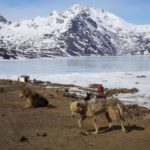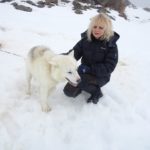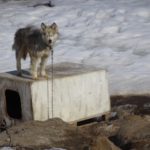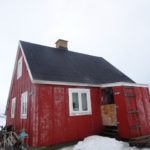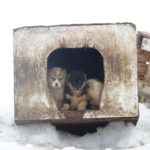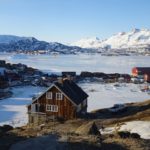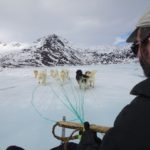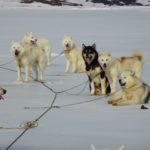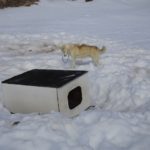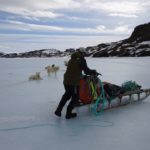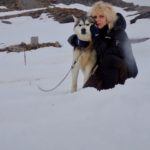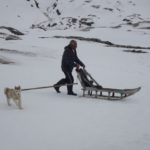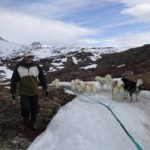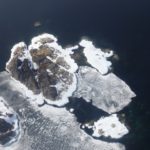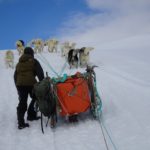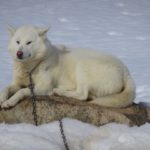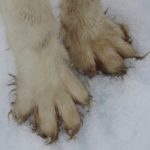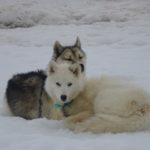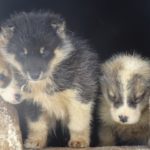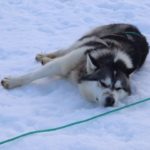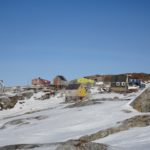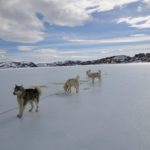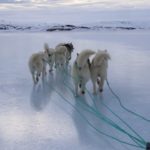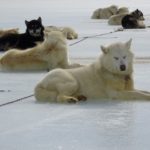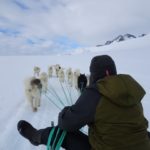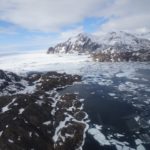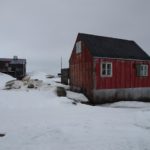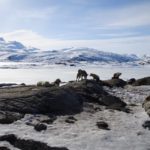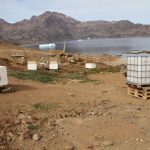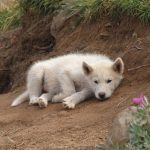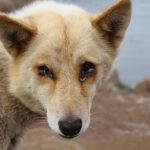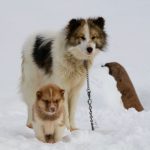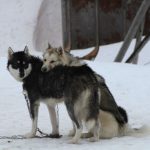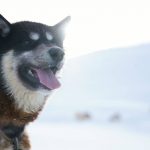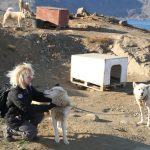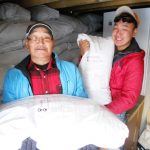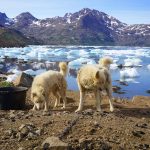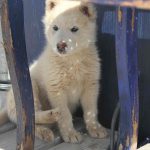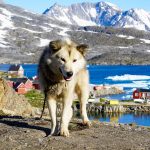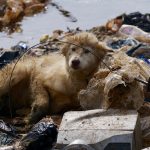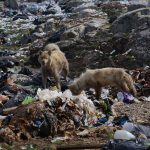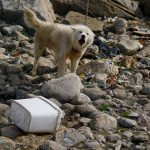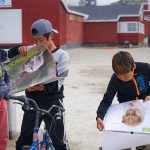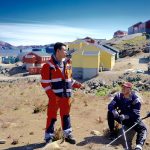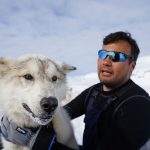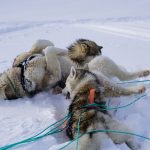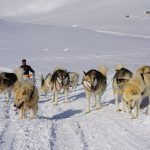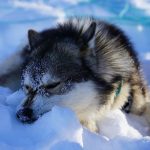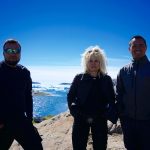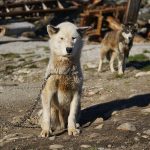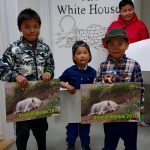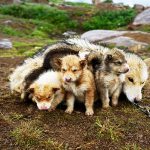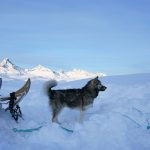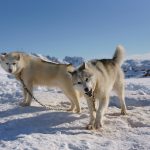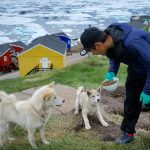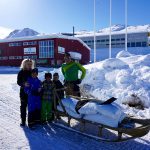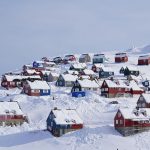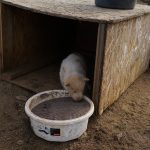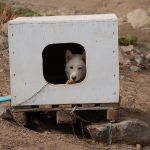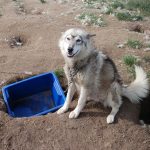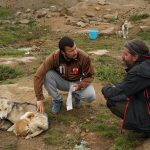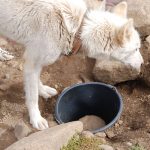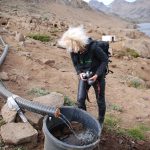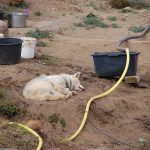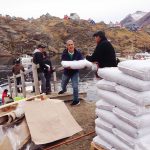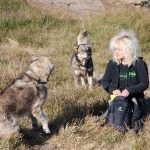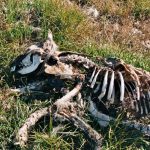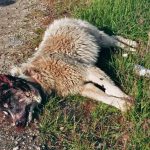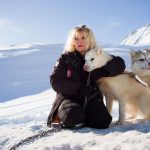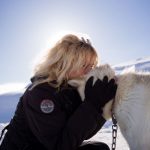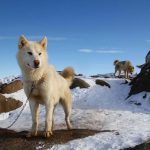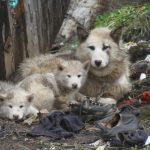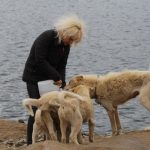Sledge dogs
Sledge dogs in East Greenland
Greenland is often associated with ice, snow, and romanticized images of the Arctic—a place where humans and animals struggle to survive the harsh cold. Sled dogs, icebergs, endless expanses, untouched nature—this is how most people picture Greenland.
The reality, however, is quite different. Around 20,000 sled dogs—so-called Greenland dogs—languished in unimaginable conditions. They spent their short lives chained up, barely provided with the essentials they needed to survive. Water and food were scarce, and there was no human affection whatsoever. Many died of thirst while chained, puppies perished on the rocky ground—Greenland’s sled dogs suffered and died unnoticed.
In August 2007, a government veterinarian reached out to me for help. The sled dogs in Greenland were in a terrible state—and I don’t just mean the tough life they’re accustomed to or the fact that they are kept on chains, but the appalling neglect. Most dogs receive little to no water in summer, hardly any food, and their chains are so tangled that mothers can’t nurse their young. There are virtually no shelters for the puppies, even though these are legally required.
In Eastern Greenland, there are no veterinarians for sled dogs.
Robin Hood wanted to help these dogs and developed a unique aid project.
We’ve already achieved a lot.
In 2012, with the help of Roar Heine Olsen, the doghouse project began. As part of a social program, unemployed young Inuit build doghouses, which can then be purchased by dog owners at a low cost. By now, more than 100 white doghouses can be seen in Tasiilaq. We aim to expand this project to reach the remote villages as well.
The water supply at the large dog area in Tasiilaq has also been largely resolved—we were able to install a water system and bring in containers from Kulusuk Airport. However, this project is still being refined and expanded.
Another major improvement came through the import of dog food from Denmark. Lars Anker Möller has high-quality dog food produced in Denmark, and Robin Hood covers the shipping costs. As a result, several tons of dog food are delivered to East Greenland twice a year. Dog owners can purchase it at a lower price because the freight costs are covered. They come by boat from the villages to collect the food.
Since then, the dogs visibly look much healthier.
Another key aspect is medical care. In East Greenland, there is no veterinarian. Dogs are often shot even though treatment would have been possible—frequently due to wounds or injuries. In 2017, Dr. Borka-Vitalis Levente from Romania traveled to Greenland. He is considered a leading expert in small animal and wildlife medicine in his country.
Recent developments also include a school project led by a teacher from France who has lived in East Greenland for 30 years. He brings dogs into the classroom, builds sleds with the children, and teaches them how to interact with dogs properly. Robin Hood has supported this effort by producing a school brochure, translated into East Greenlandic and English, which is now used in all schools across East Greenland.
Another water line is currently under construction, and the doghouse project continues as well. Robin Hood also supports dog owners who genuinely care for their animals but lack the financial means—by providing dog food.
This extremely challenging project is on the right track, and much good has truly been accomplished for the dogs.
– Marion Löcker, July 2023
Travel Report East Greenland, April 12–23, 2023
A Journey of Progress
If I’ve counted correctly, this was my 14th trip to Greenland—once to the west coast, all the other journeys led me to the east, where the Robin Hood project took root and where, over the years, a thriving little tree of animal welfare has grown.
I still remember my very first trips—sleepless nights beforehand, my stomach tying itself into a knot the size of a nut as I prepared to leave, full of anxious anticipation for what lay ahead. The solitude, the suffering of the dogs, the feeling of helplessness…
All of that feels like a distant past now. These days, it almost feels like coming home. I know many of the people; I know where to find things, what needs doing. I’ve learned so much—patience, calm, endurance. And all of that helps me take one step further each year in supporting the sled dogs.
Especially in Tasiilaq, much has changed. Emaciated dogs tangled in hopeless chains are now a thing of the past. Every dog has access to water, many are protected by our white doghouses, I often see dogs being petted, puppies kept safely in fenced enclosures, and the animals are visibly well-fed.
I tend to be modest and hesitate to claim that this is thanks to Robin Hood, but locals reassure me time and again—and I’m happy to believe them.
Each year brings new tasks, new faces, and new project partners. This year, we’re working on another water line, arranging food shipments, covering transport costs, and building more puppy enclosures with roofs—since ravens all too often snatch away the youngest.
Right at the start of my trip, I spend a night in Kulusuk. Jakob gives me a free room at the small hotel (a perk of knowing people). There, I meet three women who work as missionaries—nurses from Norway and Germany. They offer a safe space and a listening ear for the Inuit community, especially those from difficult family backgrounds.
I’d hoped to meet with the local dog inspector, but once again, he wasn’t in the village. Still, I managed to visit several dogs who are doing well, which brought some relief.
The next day, I take a helicopter to Tasiilaq. Things pick up pace quickly—Sivert picks me up and drops me at Lars’ guesthouse. I barely have time to change and repack my bag before I head into town to meet Max.
Max is a teacher in Tinit and has lived in the tiny village of 60 people for 30 years, though he originally comes from Marseille. We walk together across the frozen sea to his sled, where he’d camped overnight with his ten dogs. Together, we head toward his village—35 km away.
This year, summer has come early. The snow is slushy and disappearing in many places. Usually, good snow lasts until the end of May, but this year is different. The sled often breaks through into water—not dangerous, since there’s still thick ice underneath—but it’s hard work. The dogs push through, though not thrilled with the water, and Max has to keep encouraging them.
The dogs are eager to run, but getting ten of them harnessed and into position takes time. I stand on the brake to keep the sled from bolting before everything’s ready. Finally, we’re off—gliding over the ice, snow glittering on the mountains, the sun shining. It’s truly a dream, and the dogs clearly love to run.
But the snow conditions constantly change—we cross bare rocks and snowless patches. I keep hopping off and on the sled, and Max has to constantly evaluate the best path. Uphill, of course, we walk. Max never pushes the dogs too hard. He stays calm and steady—I admire his composure.
For me, it’s exhausting. The snow is soft, and I’m dressed too warmly. I pull off my sweater as we go. Despite the challenges, the trip is beautiful. Max calls it “high-performance sport” under these conditions, and I agree.
We meet two other sled teams along the way, and keeping all the dogs calm is no small task. Max chats with the locals—their dogs also look healthy and well cared for.
After a short chat and some juice, we carry on. It’s hours more until we reach Tiniteqilaaq. Eventually, we spot the village and approach Max’s home and the area where his dogs live. I get to help lead some of them to their spots—only the ones that accept me, of course. I quickly bond with Chopin and Armstrong—named for Max’s love of music.
Feeding time follows, and the one female who stayed behind due to her pregnancy is overjoyed at our return. She gets an extra portion for her puppies.
Later, we retreat into Max’s cozy little house. He cooks pasta, and we catch up—we’ve known each other for two years now and never run out of things to talk about.
I settle into the small room under the roof that I’ve stayed in before. Over the next few days, Max and I talk late into the night—about Greenland, the dogs, and life.
His brother Michel joins us one day for a meal, and I surprise them with how good smoked tofu and vegan nougat chocolate can taste—both things I brought along.
I cook for Max the next few days—vegan fried potatoes and vegetables from the small frozen section of the shop. The only fresh produce available is potatoes, onions, and garlic. Once the ice melts and the supply ship returns, there will be fresh fruit and vegetables again. Life here in this village of 60 souls is so different—no cars, no paved roads, just one store.
Max teaches here and also plays the organ in the “church,” which is really just a converted classroom. Only a few people attend the service, held in Greenlandic. There’s singing, and Max plays beautifully.
I wander the village during the day, visiting dogs—most of them in good condition. One elderly man still keeps dogs and receives food support from Robin Hood. He’s deeply grateful—that support lets him keep his animals.
On one of my walks, I’m by some sled dogs on a rock when I see him coming with a small sled and several puppies. He greets me, chooses one dog to pull the sled, and sets off onto the ice. It’s a moving image—the once great musher, now accompanied by just one loyal dog, shrinking into the white horizon. I stay with the other dogs, deep in thought.
Just outside the village, I find another pack—one friendly female has adorable puppies peeking out of their doghouse. She lets me pet her gently, gazing at me with bright eyes.
I remember how it used to be—how desperate I felt seeing starving, thirsty dogs with tangled chains. So much has changed. The chains, sadly, are still there—required by law—but I’m thankful for everything we’ve achieved so far.
On the way back, I walk past the dump and find a beautiful book—turns out it’s a cookbook in Greenlandic and Danish—and a tin box with a bear on it. I can’t resist and take both, even though I have no clue how to fit them in my small backpack. I proudly show Max my “treasures”—and he bursts out laughing. “I threw those out,” he says. We both laugh until our eyes water.
Max has no running water, no flush toilet—just like almost every house here. Waste is picked up every few days, and water must be collected in jugs from a central tap. No shower, no washing machine. One day I melted snow to wash my hair… it’s a different world.
The days fly by, and soon it’s time to say goodbye. I’ve grown attached to the dogs. The pregnant female’s doghouse is now clean, dry, and ready for her pups—I shoveled it out myself.
On the day of departure, I take one last walk through the village, saying farewell to the dogs. My heart grows heavy… this is my life.
